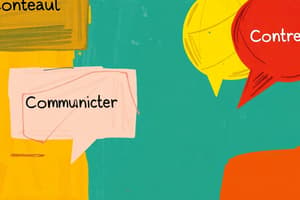Podcast
Questions and Answers
What does the term 'encoding' refer to in communication?
What does the term 'encoding' refer to in communication?
- The translation of a message for transmission (correct)
- The interpretation of a message by the receiver
- The actual act of sending the message
- The process of receiving a message
Which of the following best defines 'nonverbal communication'?
Which of the following best defines 'nonverbal communication'?
- Communication through spoken words
- Any communication that occurs in a group setting
- Communication using physical gestures and expressions (correct)
- Transmission of messages via written text
What is 'noise interference' in the context of communication?
What is 'noise interference' in the context of communication?
- The background information of the receiver
- The emotional state of the sender
- Any external factors that disrupt communication (correct)
- The sounds present during a conversation
In the communication process, what is the 'receiver'?
In the communication process, what is the 'receiver'?
What does 'media literacy' enable individuals to do?
What does 'media literacy' enable individuals to do?
What does the term 'modality' refer to in communication?
What does the term 'modality' refer to in communication?
What does 'technology literacy' encompass?
What does 'technology literacy' encompass?
What is meant by 'literacy' in the context of communication?
What is meant by 'literacy' in the context of communication?
What does information literacy primarily help an individual to do?
What does information literacy primarily help an individual to do?
Which of the following best describes 'automaticity'?
Which of the following best describes 'automaticity'?
What characterizes a 'primary source'?
What characterizes a 'primary source'?
How is 'evaluative' information defined?
How is 'evaluative' information defined?
Which of the following is considered a tertiary source?
Which of the following is considered a tertiary source?
What does the concept of normalization in media refer to?
What does the concept of normalization in media refer to?
What is the purpose of 'information fluency'?
What is the purpose of 'information fluency'?
Which of the following describes 'subjective' information?
Which of the following describes 'subjective' information?
Flashcards are hidden until you start studying
Study Notes
Communication Fundamentals
- Derived from Latin "Communicate," meaning "to share" or "to divide out."
- "Communis" translates to "working together" in Latin.
- Communication divides into verbal (spoken words) and nonverbal (gestures, body language).
Key Processes in Communication
- Encoding: Converting thoughts into a message for transmission.
- Transmitting: The act of sending the encoded message.
- Decoding: The receiver interprets and understands the message.
- Source: Origin of the message; determines the content to be communicated.
Channels and Noise
- Channels: Medium through which messages are sent (television, internet, etc.).
- Noise: Any interference that distorts the message, affecting clarity and understanding.
Communication Model
- Osgood-Schramm Model: Highlights communication as an open process, open to various interpretations influenced by context and culture.
- Modality: Refers to the nature of the message being conveyed.
- Format: How data is organized and presented.
Media and Literacy
- Media: Primary methods for disseminating information to large audiences (TV, radio, internet).
- Media Literacy: Understanding the role and value of media platforms.
- Literacy: Involves the ability to analyze, create, and communicate using print and written materials.
Types of Literacy
- Information Literacy: Recognizing the need for information, locating and evaluating sources, and effectively using and communicating that information.
- Technology Literacy: Skills in using technology independently or with assistance.
- Media Literacy: Understanding media functions and assessing the relevance of platforms.
Responsible Media Use
- Tips: Ensure privacy, get permissions, secure passwords, think critically before interacting, and promote positivity.
Automaticity and Normalization
- Automaticity: A mindset where responses occur without conscious thought.
- Normalization: Habits formed through repeated exposure to certain media messages.
Information Literacy Skills
- Identify: Recognizing the type of information needed.
- Find: Locating information efficiently.
- Evaluate: Critically assessing information quality.
- Apply: Using information effectively for specific purposes.
- Acknowledge: Recognizing sources and associated ethical issues.
Information Types
- Factual: Based on verifiable evidence from reliable sources.
- Analytical: Involves interpretation and analysis of facts.
- Subjective: Discussion focused on personal views tied to factual context.
- Objective: Unbiased information that avoids leading interpretations.
- Current: Relevance and timeliness of information.
- Historical: Contextualization of events in history.
- Scholarly: Rigorously researched, typically peer-reviewed content.
- Popular: General interest material available in common publications.
Sources of Information
- Primary Sources: Original, unaltered information (e.g., diaries, letters, photographs).
- Secondary Sources: Analysis or interpretation of primary data (e.g., textbooks, commentaries).
- Tertiary Sources: Summaries or reviews of topics that often reference primary sources (e.g., encyclopedias, bibliographies).
Studying That Suits You
Use AI to generate personalized quizzes and flashcards to suit your learning preferences.




